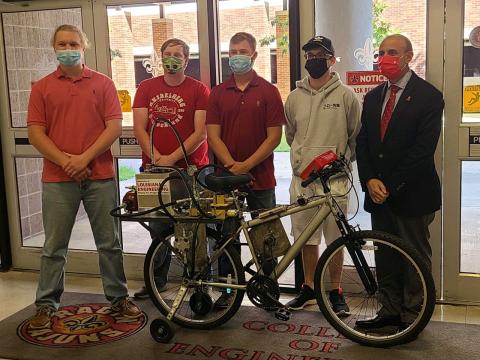The College of Engineering is excited to announce that Richard “Dan” Hereford (ME ’69) and his wife, Larry Ann, have
Mechanical Engineering students take first place in the efficiency challenge, third overall, in the National Fluid Power Vehicle Challenge
Thu, 04/29/2021 - 10:16pmCongratulations to Christopher Bertrand, John Furman, Tristan Jeansonne, and Jacob LaBerteaux! The team of Mechanical Engineering students who competed in the National Fluid Power Association’s (NFPA) annual National Fluid Power Vehicle Challenge on April 14-16, 2021 as part of their senior design project and took first place in the efficiency challenge, third place in the 500 ft. sprint race and third place overall. With the support of the NFPA and partnering sponsors, the team redesigned a bicycle to include the addition of fluid power and explored the use of hydraulics and pneumatics.

The team competed against several other universities across the nation such as Arizona State, Cal Poly State University, Colorado State, Iowa State, Purdue University, and West Virginia University Institute of Technology as well as others.
Yasmeen Qudsi a mechanical engineering instructor, served as the team’s faculty advisor and brought this challenge to the university for the first time.
“What an incredible accomplishment! I could not be more proud of our MCHE team. Opportunities such as this competition, along with our curriculum and the tireless support of our faculty help to shape our students into well-rounded leaders, entrepreneurs and innovators. Congratulations to the team and to Ms. Qudsi.,” stated Dean Ahmed Khattab
The NFPA Fluid Power Vehicle Challenge strives to promote original thinking in a competitive setting by combining two technology platforms that are not normally associated with one another—human-powered vehicles and fluid power (hydraulics and pneumatics).

